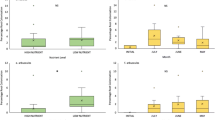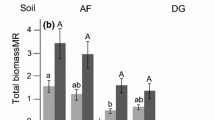Abstract
Serpentine soils represent a unique environment that imposes multiple stresses on vegetation (low Ca/Mg ratios, macronutrient deficiencies, elevated heavy metal concentrations and drought). Under these conditions, a substantial role of arbuscular mycorrhizal (AM) symbiosis can be anticipated due to its importance for plant nutrition and stress alleviation. We tested whether serpentine and non-serpentine populations of Knautia arvensis (Dipsacaceae) differ in the benefits derived from native AM fungal communities. Four serpentine and four non-serpentine populations were characterised in terms of mycorrhizal colonisation and soil characteristics. The serpentine populations showed significantly lower mycorrhizal colonisation than their non-serpentine counterparts. The mycorrhizal colonisation positively correlated with soil pH, Ca and K concentrations and Ca/Mg ratio. Seedlings from each population were then grown for 3 months in their sterilised native substrates, either uninoculated or reinoculated with native AM fungi. Two serpentine and two non-serpentine populations responded positively to mycorrhizal inoculation, while no significant change in plant growth was observed in the remaining populations. Contrary to our hypothesis, serpentine populations of K. arvensis did not show higher mycorrhizal growth dependence than non-serpentine populations when grown in their native soils and inoculated with native AM fungi.




Similar content being viewed by others
Abbreviations
- AM:
-
Arbuscular mycorrhiza, arbuscular mycorrhizal
- CEC:
-
Cation exchange capacity
- DMF:
-
Dimethylformamide
- DW:
-
Dry weight
- MGD:
-
Mycorrhizal growth dependence
- NS:
-
Non-serpentine
- PCA:
-
Principal component analysis
- S:
-
Serpentine
- SEM:
-
Standard error of the mean
References
Abbott LK, Robson AD (1985) The effect of soil pH on the formation of VA mycorrhizas by 2 species of Glomus. Aust J Soil Res 23:253–261
Allsopp N, Stock WD (1993) Mycorrhizas and seedling growth of slow-growing sclerophylls from nutrient-poor environments. Acta Oecol 14:577–587
Amir H, Perrier N, Rigault F, Jaffre T (2007) Relationships between Ni-hyperaccumulation and mycorrhizal status of different endemic plant species from New Caledonian ultramafic soils. Plant Soil 293:23–35
Amir H, Jasper DA, Abbott LK (2008) Tolerance and induction of tolerance to Ni of arbuscular mycorrhizal fungi from New Caledonian ultramafic soils. Mycorrhiza 19:1–6
Azcón R, Barea JM (1992) The effect of vesicular-arbuscular mycorrhizae in decreasing Ca acquisition by alfalfa plants in calcareous soils. Biol Fertil Soils 13:155–159
Boulet FM, Lambers H (2005) Characterisation of arbuscular mycorrhizal fungi colonisation in cluster roots of Hakea verrucosa F. Muell (Proteaceae), and its effect on growth and nutrient acquisition in ultramafic soil. Plant Soil 269:357–367
Brady KU, Kruckeberg AR, Bradshaw HD (2005) Evolutionary ecology of plant adaptation to serpentine soils. Annu Rev Ecol Evol Syst 36:243–266
Castelli JP, Casper BB (2003) Intraspecific AM fungal variation contributes to plant-fungal feedback in a serpentine grassland. Ecology 84:323–336
Chiarucci A, Maccherini S, Bonini I, De Dominicis V (1999) Effects of nutrient addition on community productivity and structure of serpentine vegetation. Plant Biol 1:121–126
Clark RB, Zeto SK (2000) Mineral acquisition by arbuscular mycorrhizal plants. J Plant Nutr 23:867–902
Doherty JH, Ji BM, Casper BB (2008) Testing nickel tolerance of Sorghastrum nutans and its associated soil microbial community from serpentine and prairie soils. Environ Pollut 151:593–598
Fitzsimons MS, Miller RM (2010) Serpentine soil has little influence on the root-associated microbial community composition of the serpentine tolerant grass species Avenula sulcata. Plant Soil 330:393–405
Goncalves SC, Martins-Loucao MA, Freitas H (2001) Arbuscular mycorrhizas of Festuca brigantina, an endemic serpentinophyte from Portugal. S Afr J Sci 97:571–572
Gustafson DJ, Casper BB (2004) Nutrient addition affects AM fungal performance and expression of plant/fungal feedback in three serpentine grasses. Plant Soil 259:9–17
Hepper CM, Oshea J (1984) Vesicular-arbuscular mycorrhizal infection in lettuce (Lactuca sativa) in relation to calcium supply. Plant Soil 82:61–68
Hetrick BAD (1991) Mycorrhizas and root architecture. Experientia 47:355–362
Hopkins NA (1987) Mycorrhizae in a California serpentine grassland community. Can J Bot 65:484–487
Jarstfer AG, Farmer-Koppenol P, Sylvia DM (1998) Tissue magnesium and calcium affect arbuscular mycorrhiza development and fungal reproduction. Mycorrhiza 7:237–242
Jenny H (1980) The soil resource: origin and behavior. Springer, New York
Ji BM, Bentivenga SP, Casper BB (2010) Evidence for ecological matching of whole AM fungal communities to the local plant-soil environment. Ecology 91:3037–3046
Johnston WR, Proctor J (1981) Growth of serpentine and non-serpentine races of Festuca rubra in solutions simulating the chemical conditions in a toxic serpentine soil. J Ecol 69:855–869
Jun DJ, Allen EB (1991) Physiological responses of 6 wheatgrass cultivars to mycorrhizae. J Range Manag 44:336–341
Kaplan Z (1998) Relict serpentine populations of Knautia arvensis s.l. (Dipsacaceae) in the Czech Republic and an adjacent area of Germany. Preslia 70:21–31
Kazakou E, Dimitrakopoulos PG, Baker AJM, Reeves RD, Troumbis AY (2008) Hypotheses, mechanisms and trade-offs of tolerance and adaptation to serpentine soils: from species to ecosystem level. Biol Rev 83:495–508
Koide RT, Mooney HA (1987) Spatial variation in inoculum potential of vesicular arbuscular mycorrhizal fungi caused by formation of gopher mounds. New Phytol 107:173–182
Kolář F, Štech M, Trávníček P, Rauchová J, Urfus T, Vít P, Kubešová M, Suda J (2009) Towards resolving the Knautia arvensis agg. (Dipsacaceae) puzzle: primary and secondary contact zones and ploidy segregation at landscape and microgeographic scales. Ann Bot 103:963–974
Koske RE, Gemma JN (1989) A modified procedure for staining roots to detect VA mycorrhizas. Mycol Res 92:486–505
Kothari SK, Marschner H, Romheld V (1990) Direct and indirect effects of VA mycorrhizal fungi and rhizosphere microorganisms on acquisition of mineral nutrients by maize (Zea mays L.) in a calcareous soil. New Phytol 116:637–645
Lagrange A, Ducousso M, Jourand P, Majorel C, Amir H (2011) New insights into the mycorrhizal status of Cyperaceae from ultramafic soils in New Caledonia. Can J Microbiol 57:21–28
Leyval C, Turnau K, Haselwandter K (1997) Effect of heavy metal pollution on mycorrhizal colonization and function: physiological, ecological and applied aspects. Mycorrhiza 7:139–153
Lindsay WL, Norvell WA (1978) Development of a DTPA soil test for zinc, iron, manganese, and copper. Soil Sci Soc Am J 42:421–428
Liu A, Hamel C, Hamilton RI, Smith DL (2000) Mycorrhizae formation and nutrient uptake of new corn (Zea mays L.) hybrids with extreme canopy and leaf architecture as influenced by soil N and P levels. Plant Soil 221:157–166
Liu A, Hamel C, Elmi A, Costa C, Ma B, Smith DL (2002) Concentrations of K, Ca and Mg in maize colonized by arbuscular mycorrhizal fungi under field conditions. Can J Soil Sci 82:271–278
Malcová R, Gryndler M, Vosátka M (2002) Magnesium ions alleviate the negative effect of manganese on Glomus claroideum BEG23. Mycorrhiza 12:125–129
Marschner H (2002) Mineral nutrition in higher plants. Academic, London
McGonigle TP, Miller MH, Evans DG, Fairchild GL, Swan JA (1990) A new method which gives an objective measure of colonisation of roots by vesicular-arbuscular mycorrhizal fungi. New Phytol 115:495–501
O'Dell RE, James JJ, Richards JH (2006) Congeneric serpentine and nonserpentine shrubs differ more in leaf Ca:Mg than in tolerance of low N, low P, or heavy metals. Plant Soil 280:49–64
Olsen SR, Sommers LE (1982) Phosphorus. In: Page AL, Miller RH, Keeney DR (eds) Methods of soil analysis. 2. Chemical and microbiological properties, 2nd edn. American Society of Agronomy, Madison, pp 403–430
Porra RJ, Thompson WA, Kriedemann PE (1989) Determination of accurate extinction coefficients and simultaneous equations for assaying chlorophylls a and b extracted with four different solvents: verification of the concentration of chlorophyll standards by atomic absorption spectroscopy. Biochem Biophys Acta 975:384–394
Proctor J (1971) Plant ecology of serpentine. II. Plant response to serpentine soils. J Ecol 59:397–410
Proctor J, Woodell SRJ (1975) The ecology of serpentine soils. Adv Ecol Res 9:255–365
Rillig MC, Mummey DL (2006) Mycorrhizas and soil structure. New Phytol 171:41–53
Sambatti JBM, Rice KJ (2007) Functional ecology of ecotypic differentiation in the Californian serpentine sunflower (Helianthus exilis). New Phytol 175:107–119
Schechter SP, Bruns TD (2008) Serpentine and non-serpentine ecotypes of Collinsia sparsiflora associate with distinct arbuscular mycorrhizal fungal assemblages. Mol Ecol 17:3198–3210
Schüssler A, Schwarzott D, Walker C (2001) A new fungal phylum, the Glomeromycota: phylogeny and evolution. Mycol Res 105:1413–1421
Smith SE, Read DJ (2008) Mycorrhizal symbiosis. Academic, London
Smith SE, Smith FA, Jakobsen I (2003) Mycorrhizal fungi can dominate phosphate supply to plants irrespective of growth responses. Plant Physiol 133:16–20
Smith SE, Facelli E, Pope S, Smith FA (2010) Plant performance in stressful environments: interpreting new and established knowledge of the roles of arbuscular mycorrhizas. Plant Soil 326:3–20
Štěpánek J (1997) Knautia L. – chrastavec. In: Slavík B (ed) Květena České republiky 6 [Flora of the Czech Republic 6]. Academia, Prague, pp 543–554
Sudová R, Rydlová J, Münzbergová Z, Suda J (2010) Ploidy-specific interactions of three host plants with arbuscular mycorrhizal fungi: Does genome copy number matter? Am J Bot 97:1798–1807
Turnau K, Mesjasz-Przybylowicz J (2003) Arbuscular mycorrhiza of Berkheya coddii and other Ni-hyperaccumulating members of Asteraceae from ultramafic soils in South Africa. Mycorrhiza 13:185–190
van Aarle IM, Olsson PA, Söderström B (2002) Arbuscular mycorrhizal fungi respond to the substrate pH of their extraradical mycelium by altered growth and root colonization. New Phytol 155:173–182
Vivas A, Biró B, Németh T, Barea JM, Azcón R (2006) Nickel-tolerant Brevibacillus brevis and arbuscular mycorrhizal fungus can reduce metal acquisition and nickel toxicity effects in plant growing in nickel supplemented soil. Soil Biol Biochem 38:2694–2704
Wang B, Qiu YL (2006) Phylogenetic distribution and evolution of mycorrhizas in land plants. Mycorrhiza 16:299–363
Wellburn AR (1994) The spectral determination of chlorophylls a and chlorophyll b, as well as total carotenoids, using various solvents with spectrophotometers of different resolution. J Plant Physiol 144:307–313
Acknowledgements
Financial support of the Grant Agency of the Academy of Sciences of the Czech Republic (project KJB600050812 to R.S.) and the Grant Agency of Charles University (project 13409 to P.D.) is gratefully acknowledged. Additional support was provided by the Academy of Sciences of the Czech Republic within the institutional research programme (AV0Z 60050516) and by the Ministry of Education, Youth and Sports of the Czech Republic (project MSM0021620828). The authors are grateful to M. Albrechtová and her team from the Analytical Laboratory of the Institute of Botany AS CR for the chemical analyses of plant biomass and soils. Sincere thanks are due to F. Kolář and M. Štech for providing information on K. arvensis localities and to P. Trávníček and Z. Sýkorová for their kind advice on the ordination analysis.
Author information
Authors and Affiliations
Corresponding author
Additional information
Responsible Editor: Erik J. Joner.
Rights and permissions
About this article
Cite this article
Doubková, P., Suda, J. & Sudová, R. Arbuscular mycorrhizal symbiosis on serpentine soils: the effect of native fungal communities on different Knautia arvensis ecotypes. Plant Soil 345, 325–338 (2011). https://doi.org/10.1007/s11104-011-0785-z
Received:
Accepted:
Published:
Issue Date:
DOI: https://doi.org/10.1007/s11104-011-0785-z




